Daniel Laine’s photography book on African Kings
Author: Daniel Laine
Note: The author's views are entirely his or her own and may not reflect the views of RetoxMagazine.com
African Kings: Portraits of a Disappearing Era
Between 1988 and 1991 French photographer Daniel Laine spent about 12 months on the African continent tracking down and photographing figures of royalty and leaders of kingdoms. 70 photographed monarchs and descendants of the great African dynasties are published in his fine book entitled "African Kings".
SALOMON IGBINOGHODUA (above) - Oba Erediauwa of Bénin, Nigeria
On march 23, 1979, prince Salomon, a graduate of Cambridge University, was crowned Oba (king) of Benin. He succeeded his father Akenzua II, and became the thirty-eighth king of a dynasty dating back to the thirteenth century.
"The large chalk stick is broken" was the metaphor used to officially announce the death of Akenzua. Immediately afterwards, the Edo of Nigeria, England and America, shaved their heads. The new growth of the hair signified the rebirth of the kingdom and the re-establishment of the harmony between man and the elements that had been broken for an instant by the death.
NYIMI KOK MABIINTSH III - King of Kuba, D.R. Congo
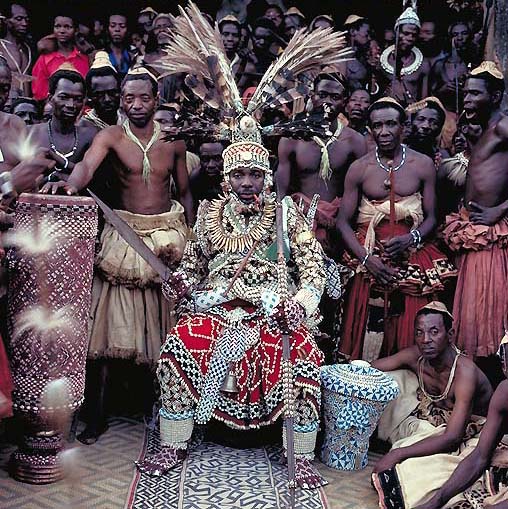
Nyimi Mabiintsh III, King of Kuba, D.R. Congo in Daniel Laine’s book African Kings.
The Nyimi Mabiintsh III is fifty years old. He acquired the throne at the age of twenty. As a descendant of god the creator, the king is attributed with supernatural powers.
Due to his top position he is restricted by several constraints: he does not have the right to sit on the ground and he cannot cross a cultivated field. Apart from his cook, no one has seen him eat. Moreover he never travels without him and his personal cooking utensils.
It took Daniel Laine three weeks to photograph the Nyimi (king) of the Kuba in his royal apparel, the "bwantshy". The outfit made out of material stitched with beads and "cauris" (small shells used as money in Africa), weighs 160 lb. It takes more than two hours to dress the King, and two days of spiritual preparation to be sufficiently purified in order to wear the outfit.
The weight and the heat of the bwantshy is such, that it is impossible to wear it more than one hour. The preceding King had only worn it three times during his entire life.
EL HADJ SEIDOU NJIMOLUH NJOYA - Sultan of Fumban and Mfon of the Bamun, Cameroun
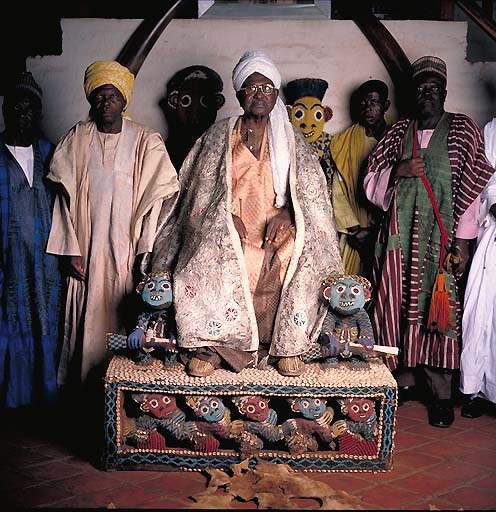
El Hadj Seidou Njimoluh Njoya, Sultan of Fumban and Mfon of the Bamun, Cameroun in Daniel Laine’s book African Kings.
Eighty years old, the sultan Njoya has been on the throne for more than fifty years.
At the age of twenty-nine he inherited the famous Bamun throne founded in the sixteenth century. He was chosen by the kingdom’s council of wisemen, among one hundred and seventy seven of his father’s children, the famous Sultan Njoya.
His father, an enlightened sovereign, spent twelve years to invent his own alphabet made of eighty symbols. He wanted to be able to write in the Bamun language the kingdom’s history. At this time the oral tradition dominated.
In 1913, while Cameroun was still a German colony, Sultan Njoya equipped himself with his own printing house.
AGBOLI-AGBO DEDJLANI - King of Abomey, Benin
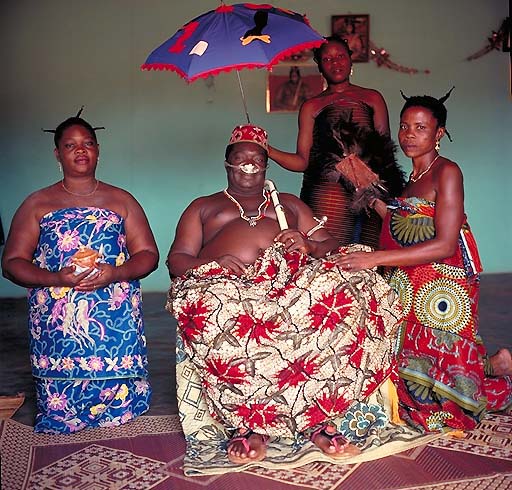
Agboli-Agbo Dedjlani, King of Abomey, Benin in Daniel Laine’s book African Kings.
Dedjlani, a former policeman, waited six years to retire, and then proceeded with his secret coronation ceremonies.
"Officially" there is no longer a king in Benin. But on September 30, 1989, Dedjlani put on his royal shoes and at the age of fifty-four became King of Abomey.
Being monogamous he was obliged to marry two more wives to take care of his royal household. When he goes out tradition requires that he be sheltered under an umbrella with his emblem. One of wives must always be next to him carrying the royal spitting bowl. The King also has to wear his sceptre in permanence. Holding it in his hand or hanging on his shoulder, more than a symbol, the sceptre is the King.
The silver dust protector worn on the nose dates from the nineteenth century, and was inherited from the King Gbehanzin. It protected the King’s nose from the dust during the royal processions in Abomey.
GOODWILL ZWELETHINI - King of Zulu, South Africa
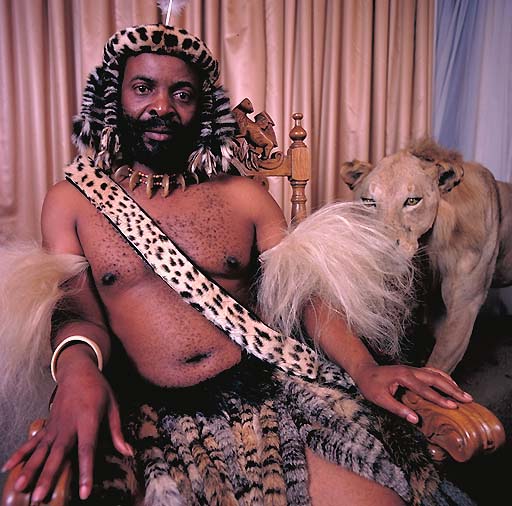
King Goodwill Zwelethini of Zulu, South Africa in Daniel Laine’s book African Kings.
King Goodwill Zwelethini is a descendant of the famous Shaka, founder of the Zulu kingdom.
At the beginning of the nineteenth century, Shaka was the chief of a small insignificant clan among the Bantu people. Thinking that the survival of the Zulus depended inevitably on the subservience of the other clans, Shaka submitted the natal region to blood and fire. Between 1815 and 1828 he annihilated all tribes that were opposed to him. This troubled period referred to as Mfecan (terror), was accompanied by famine and exodus of a large part of the Bantu population. Shaka’s cruelty became legendary.
BOUBA ABDOULAYE - Sultan of Rey-Bouba, Cameroun
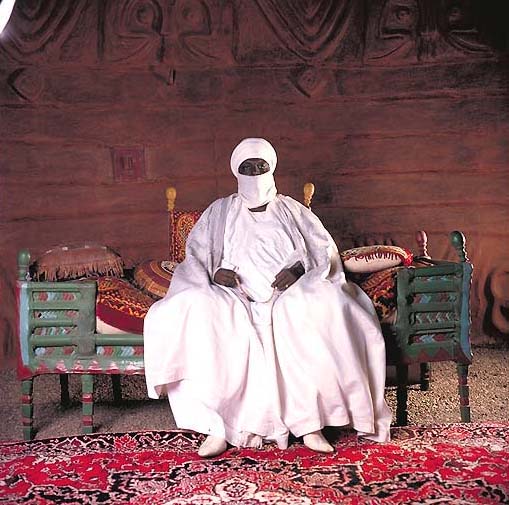
Bouba Abdoulaye, Sultan of Rey-Bouba, Cameroun featured in Daniel Laine’s book African Kings.
The Baba (sultan) of Rey-Bouba rules over fifty five thousand subjects, and his territory is as large as Belgium and Luxemburg reunited (35 000Km2).
It is wrong to call him Lamido, because he was never a vassal to Sokoto.
A former parliamentarien in the Camerounian Assembly, Bouba Abdoulaye had to leave everything and renounce modern life in order to suceed his father. His great-grand father, Bouba Ndjidda came from Mali in 1799, with his Fulani warriors, and decided to settle on the borders of Adamawa, at the edge of the Mayo-Rey river. He placed a white flag, a silver drum, a sword and a basket containing the royal secrets, and built a palace with a surrounding wall that was 800 meters long and seven meters high.
Today these walls shelter one of the most traditional soverains of Africa. He exercises an invisible and permanent power. He is only allowed to go out three times during the year. The Baba is the center of the world and the kingdom. He knows everything, and has to know everything. Hundreds of agents keep him informed of all the movements and acts in his kingdom.
OBA JOSEPH ADEKOLA OGUNOYE - Olowo of Owo, Nigeria
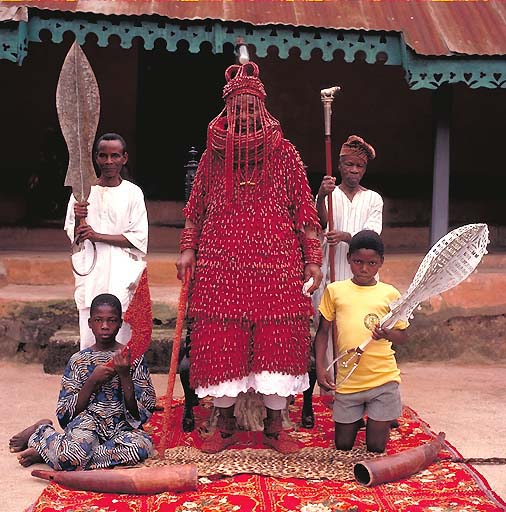
Oba Joseph Adekola Ogunoye, Olowo of Owo, Nigeria featured in Daniel Laine’s book African Kings.
Six hundred years ago, Olowo, the King, fell in love with Orensen, a very beautiful woman. Unfortunately for the King, she was a goddess who could not live with a human. She was forbidden to see women pounding spices, draw water, or throw a bundle of wood to the ground.
Because of his love for the goddess, and in order to marry her, the King promised her that his other wives, in front of her would follow these same restrictions. After several years, the King’s wives became jealous and revolted. They did everything they were not supposed to do in front of the goddess, who then cast a spell upon the entire kingdom. The goddess promised that people of Owo would die of famine or sickness if the King and his chiefs did not celebrate every year a ceremony in her honour. The drums should beg her pardon and sing her praises. One also had to offer her a sacrifice of a man and a woman.
This ceremony, Igogo, still exists, but the human beings have been replaced by a sheep and a goat.
DANIEL LAINE - King of Photography
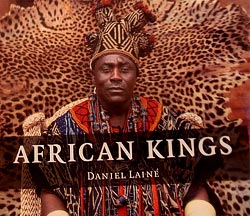
Front cover of the book African Kings: Portraits of a Disappearing Era by photographer Daniel Laine.
Daniel Laine’s work on the Kings of Africa was rewarded the prize of the Villa Medicis in 1988, and a 1st prize of World Press Photo in 1991.
Although it is old work now (completed between 1988/91) many of us are still impressed by the access Daniel Laine managed to secure, the exotic costumes the rulers were photographed in and the general insight into a modern Africa where the past is still very much present.
With each striking photograph, Daniel Laine provides a brief biography and historical notes about the tribe and its rituals. The book, African Kings: Portraits of a Disappearing Era was published in 2000 by Ten Speed Press. Laine lives in France.










